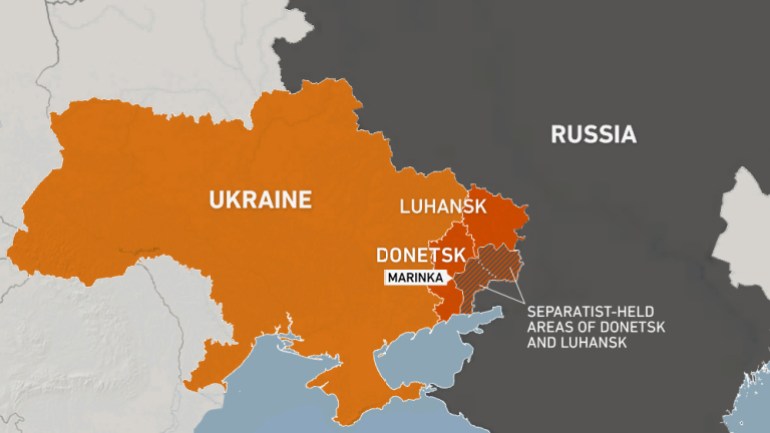The other Russian interventions in its periphery | News
Russian President Vladimir Putin on Monday recognised Ukraine’s breakaway regions of Donetsk and Luhansk, drawing condemnation from the West that fears Moscow is planning to invade its western neighbour.
Russia has amassed tens of thousands of troops on borders with Ukraine and carried out military drills in neighbouring Belarus – a key Russian ally for decades. Moscow has maintained it does not seek war but has demanded that Kyiv should not be granted the membership of NATO military alliance.
Putin’s latest decision has triggered Western sanctions and fuelled fears of a major escalation.
Moscow has been involved militarily in a number of countries in the region and beyond in recent decades.
Here is a brief explainer on what led to the Russian interventions into Donetsk and Luhansk, which are part of Ukraine’s Donbas region, and Crimea in 2014 and Abkhazia and South Ossetia (separatist regions in Georgia) in 2008.
Crimea and Donbas
The crisis that led to Ukraine’s annexation of Crimea and war in eastern Ukraine mainly happened because of an internal conflict.
In November 2013, Ukraine’s pro-Russia President Viktor Yanukovych rejected a deal with the European Union that was seen as a first step to becoming a full member of the bloc.
The move sparked mass protests, which led to clashes between the security forces and protesters, as Yanukovych attempted to stop the movement violently.
During the anti-government protests, known as the Maidan movement, dozens of people were killed. Moscow stood behind Yanukovych, while the West supported the protesters.
Yanukovych fled the country in February 2014 after days of protests.

During the same period, Moscow conducted military drills on its border with Ukraine, and at Russia’s Black Sea base near the Crimean Peninsula.
Meanwhile, armed men with no insignia on their uniforms, mostly wearing masks, started seizing government buildings in Crimea.
The Kremlin rejected any affiliation with them and defined the attackers as a local movement.
In the chain of events after the fall of the Crimean parliament by pro-Russian forces in late February, a new government was formed of pro-Russian figures and a referendum was held on Crimea’s future in March.
Some 95 percent of voters in Crimea supported joining Russia, according to the new government at the time holding the disputed referendum. On March 18, Russia officially annexed Crimea.
Following Russia’s takeover of Crimea, pro-Russian protesters took to the streets in Donetsk and Luhansk regions, which are part of Donbas, targeting and invading state institutions in early April, demanding the regions to be part of Russia.
Subsequently, armed soldiers with no insignia kept targeting the state institutions and security forces. Separatists began seizing territory in parts of Donbas region.
They declared independence in Donetsk and Luhansk regions, starting a war, with apparent support from Russia, against the Ukrainian army. At least 14,000 have been killed in fighting between rebels and Ukrainian forces.
Abkhazia and South Ossetia
Russia’s military operation on the two Georgian regions in 2008 mainly stemmed from President Mikhail Saakashvili’s coming to power in 2004 with the Rose Revolution in Georgia, overthrowing former Soviet leader Eduard Shevardnadze.
Saakashvili changed the former policies of his country significantly, eager for his country to become a European Union and NATO member.
He also changed Tbilisi’s policies towards Georgian regions of South Ossetia and Abkhazia, which both stayed pro-Russia after the fall of the Soviet Union. The Saakashvili government policies to integrate the two regions led to violence at times.
The Georgian parliament’s unanimous vote for a bill to integrate Georgia into NATO in September 2006 led to increased tensions between Georgia and Russia.
Moscow, traditionally opposed to any Western expansion in its periphery, hit back at the Tbilisi government by imposing sanctions and deporting hundreds of Georgians from the country. Georgia arrested four Russian army officers for spying in late September.
After Kosovo declared independence from Serbia in February 2008, a move Moscow staunchly opposed, Russia took steps to enhance its ties with South Ossetia and Abkhazia, including increased economic aid and diplomatic support.
As skirmishes continued in the regions and after months of mutual accusations and provocations, Georgia conducted a military operation to capture the South Ossetian capital of Tskhinvali in August 2008.
Russia responded with air raids on Georgian positions in South Ossetia, as well as Abkhazia, and subsequently moved troops into the regions in the five-day conflict.
Russian forces quickly took control of Tskhinvali and rolled tanks and troops through Ossetia into Georgia, reportedly stopping only a few dozen kilometres away from Tbilisi.
A ceasefire was reached on August 12.

Pingback: cam coins
Pingback: live cams
Pingback: Info
Pingback: th168
Pingback: บาคาร่าเกาหลี
Pingback: 1xbet chile